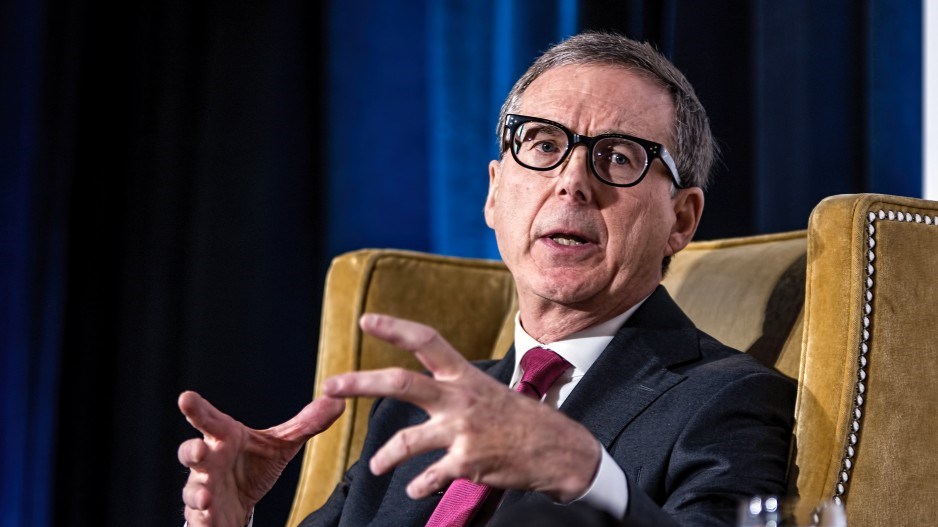The Bank of Canada held its key interest rate steady and telegraphed that it may need to keep rates higher for longer as the effects of tighter borrowing conditions continue to ripple through the economy.
The central bank, which also released a new economic forecast Wednesday, said recent data has reinforced its confidence that inflation will continue to fall in the coming months.
Bank of Canada governor Tiff Macklem said price growth is easing quickly and will slow to about three per cent this summer, while the economy is expected to grow modestly even as inflation comes down.
"This is good news, but it is not job done," Macklem said at a news conference in Ottawa.
"Our destination is the two per cent inflation target, and several things have to happen to get inflation all the way back to the two per cent target. Inflation expectations have to come down further, services price inflation and wage growth need to moderate, and corporate pricing behaviour has to normalize."
Economists were widely anticipating the Bank of Canada to maintain its interest rate at 4.5 per cent as inflation eases meaningfully, while also keeping the door open to future rate hikes if necessary.
Canada’s annual inflation rate fell to 5.2 per cent in February, marking the second month in a row it came in lower than forecast. The Bank of Canada expects the inflation rate to fall to three per cent by mid-year and back down to two per cent by the end of 2024.
Its decision to stay on the sidelines comes as the economy posts stronger-than-expected growth and the labour market remains exceptionally tight — both signs of a still-hot economy.
In its quarterly monetary policy report released Wednesday, the central bank’s updated forecasts suggest it expects the economy to still slow, just a little later than previously anticipated.
It’s now expecting real gross domestic product to grow by 1.4 per cent this year, up from its previous forecast of 1.0 per cent.
And while the stronger growth didn't push the central bank to raise rates again, Macklem said interest rates might have to stay high for longer.
"The implied expectation in the market that we are going to be cutting our policy rate later in the year, that doesn't look today like the most likely scenario to us," Macklem said.
The governor highlighted repeatedly that inflation expectations are still a concern for the central bank. Recent surveys conducted by the Bank of Canada show consumers and businesses are still expecting inflation to remain higher than its own forecasts.
But Royce Mendes, managing director and head of macro strategy at Desjardins, was skeptical of the Bank of Canada's assertion that rate cuts later this year are unlikely.
"We can see the Bank of Canada and Tiff Macklem in particular, doing their best to put on a brave face and say that these high interest rates are going to remain in place for some time," Mendes said. "Now, whether or not that's true is a different story."
Mendes said the central bank's forecasts for growth appear to be optimistic, while inflation could come down faster than it's anticipating.
"There's a lot of time between now and the end of the year. And nobody knows what's going to happen," he said.
Laval University economics professor Stephen Gordon said he doesn't believe the Bank of Canada will be ready to cut rates if inflation is still above the two per cent target.
"I don't think they're going to make a major policy move based on a forecast," Gordon said.
The Bank of Canada lowered its growth forecast for 2024 and is expecting the economy to bounce back in 2025 as demand for Canadian exports strengthens and the effects of past rate hikes fades.
Globally, the Bank of Canada said growth has been stronger than anticipated, also leading to an upward revision to growth this year and a downward revision for next year.
Looking ahead, the path back to low inflation and stronger growth in Canada relies on high interest rates working effectively.
Since March of last year, the Bank of Canada has aggressively raised its key interest rate to stifle inflation.
But after its historic monetary policy tightening, the Bank of Canada has hit the pause button. It announced earlier this year it plans to hold its key interest rate steady to allow time for the effects of higher borrowing costs to broaden out in the economy.
Given the run-up in prices largely occurred in the first half of 2022, the slowdown in inflation this year was largely expected. However, economists and the central bank are concerned getting back to the two per cent target might be more challenging, with some components of inflation still sticky.
The central bank’s concern stems from several factors, including consumers and businesses expecting future inflation to be higher than the Bank of Canada’s forecasts. It’s also concerned about prices for services still rising rapidly — in part due to rapid wage growth — and businesses still able to easily pass on higher prices to consumers.
The central bank said its governing council will be watching these indicators along with core inflation closely, as it sets monetary policy moving forward.
This report by The Canadian Press was first published April 12, 2023.
Nojoud Al Mallees, The Canadian Press





